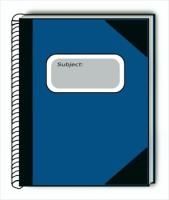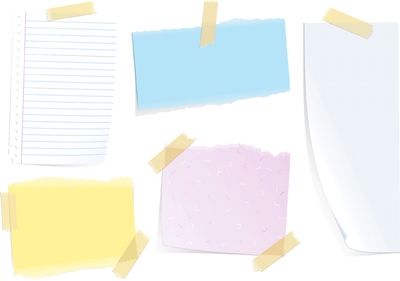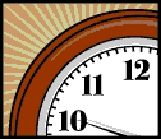Visual diary? What's that?

Visual diary, artist's journal, studio diary
These are all descriptions of workbooks kept by practitioners in which they record ideas, designs, thoughts, inspirations, indeed anything that will help them in their artistic pursuits
They can be quite elaborate, or very basic.
What matters is that artists in any medium keep track of that 'great idea'.

What do you do when
a design idea strikes?
Reach for the nearest bit of something to write it down?
Use the back of a shop receipt or a paper serviette in a cafe?
And when you want these flashes of design creativity, where are they? Can't remember where you put them? Or even why you took the time to write them down?
Many quilt/textile/mainstream artists would agree that they have tucked away in a drawer or a box, pictures or drawings of a truly great idea.
Would you know where you put that diagram for a fabulous quilt, or a prizewinning artwork?
Would you remember why it appealed at the time?
Don't lose the scraps of paper - you'll lose the inspirations you wrote on them


Experiments are useful
but only if you know why you were experimenting!
In my studio there is a large box labelled 'experiments'.
For some of these I remember why I tried out the technique, while some I have no idea what they were about.
If I had recorded this information, how much more useful would the contents of my experiments box be?
Even if your ideas are scrappy, they can be a source to 'jumpstart' a new piece.

What can you do
to make your jottings more useful or findable?
Keep them all in one place.
A dear friend has been encouraging me for years to combine all my ideas into a permanent record, instead of in manila file folders full of what I call 'cartoons' for my quilt designs. Since she began her journals, she has had immense benefit from doing so.
My manila folders are not kept in any order, and scrabbling around in them is not always productive, even if I enjoy looking at the things inside.
I remember saying to one of my daughters very early in my career when an art quilt competition flyer arrived, "I wish I could design a quilt like that."
She said "You already have. It's in your cartoons."
So should you get a huge filing cabinet and set it up to hold alphabetical files for all your design ideas? Not at all.
This is where a visual diary comes into play.
What are they?
Many things, from envelopes to large bound volumes...
What is a visual diary?
It can be physically as simple as an exercise book...
...or a specially produced book which you can buy from any good stationers or art supply shop.
The notion is not to categorise the ideas, as you would in a filing system, but to just record the reasons you chose to draw, snip out or jot down a thought.
You glue the scraps of paper that hold your scribblings into the pages, but here's the difference between a simple scrapbook and a visual diary:
You also write quick notes about what inspires you about these snippets, then when you peruse the journal, you know why you chose that particular item as inspiration.
They do not have be balanced artistically, or arranged in any order on the page, you simply add to them as you want, even adding more notes as something else strikes you much later on.
One by-product of keeping these journals is that you can get very side-tracked as you look back through them!
It's good artistic practice
to keep a studio journal
Start a new journal for each new direction your work takes.
Use the pages to record your experiments, your adventures into the new road. This documentation can be important as a learning tool, and may trigger new adventures in your artistic endeavours.
Jotting down what worked — or didn't, and whether the direction you are heading is producing works that you are pleased with, can increase your discernment of who you are as artist.
What do these journals look like?
Anything from scrapbooks to artworks in their own right.
From quite literally bits of paper stuck into a notebook to fabulous expressions of the maker's philosophy.
Here is a wonderful example of one of these journals: Nirmal Dhiman
And here's a picture of a page from one of my friend's diaries and a link to the resulting work:
Pages from Annie's journal

What can you use for a visual journal?
Blank journals, notebooks, diaries, or art sketchbooks
It is usually best to have blank paper so you can draw or write, without the lines interfering in the creative process.
Anything you can paste onto, or draw/paint into, can be used to create visual diary pages.
Some creative artists use good quality loose paper, and insert the pages into a folder.
Yet others use old used books with hard covers and paste the journal pages over the original pages. (Altered books are examples of this.)
Altered books on Amazon - a great idea for a visual diary

What goes in?
Whatever inspires you!
Does my diary have to be artistic?
Not at all, but as you are an artist...
The idea is to add to it as and when you want, with whatever is to hand. You can paint in your idea, paste a cutting from a magazine, glue in a photograph, write some words.
Even though you might end up with an artistic creation, if your diary/journal is 'rough and ready' then your valuable creative time won't be spent on the production of the journal, instead of producing your real work.
Use your journal as a pictorial and written record of the inspirations that come to you as you go about your daily life.

Adding to your journal
becomes part of your daily routine
Here are some suggestions from staff at the Gippsland Centre for Art & Design for how to do this:
- Be constructively critical of your own work.
- Express your opinion about art and various issues.
- Describe your approach to your current project and what you are trying to achieve.
- Describe what you would call your 'personal' expression or what you are trying to communicate through your work.
- Record any opinions of staff or other students about your work, including your reaction to these criticisms.
- Describe as precisely as possible your reactions to all exhibitions you see. Try to analyse what makes something good or bad in your view.
- Offer opinions about artists' talks you attend.
- Note your positive and negative reactions to art and design, artists and designers, and art and design movements in both historical and contemporary contexts.
- Comment on the formal elements within your work such as composition, colour, form, line, volume, shape, space, texture and pattern.
- Include pictures of work by designers and artists you like. These can be useful as reference material and points of discussion.
- Include any diagrams or images you may be using as source material. Use anything that grabs your attention.
- Try to describe your responses to what you see and read, as well as experiences you have. Your life and your environment will feed your work.
Blank journal books on Amazon


How much time will all this take?
I don't have enough hours in the day now!
Time is relative. If you make recording your ideas part of your routine, then it takes just a few minutes each time you need to make an entry.
Some people set aside a time weekly for keeping the journal up to date.
For me it is a more spontaneous task, entering things when inspiration comes.
Visual journalling on Amazon
Have you started your own studio journal?
Do you keep a visual diary for your art?
Feast your eyes on these!
- Visual Art Diary - Art Journal - ArtStuff : ArtStuff
- Artist's Sketchbook Visual Journals: How to Keep & Create an artistic visual journal
View the sketchbook visual journals of Michael Bell's student artists and see how visual journaling unlocks their creative art-making process by expanding from our ideas that are explored in our sketchbooks to the creation of larger works on canvas a
© 2009 Jan T Urquhart Baillie




